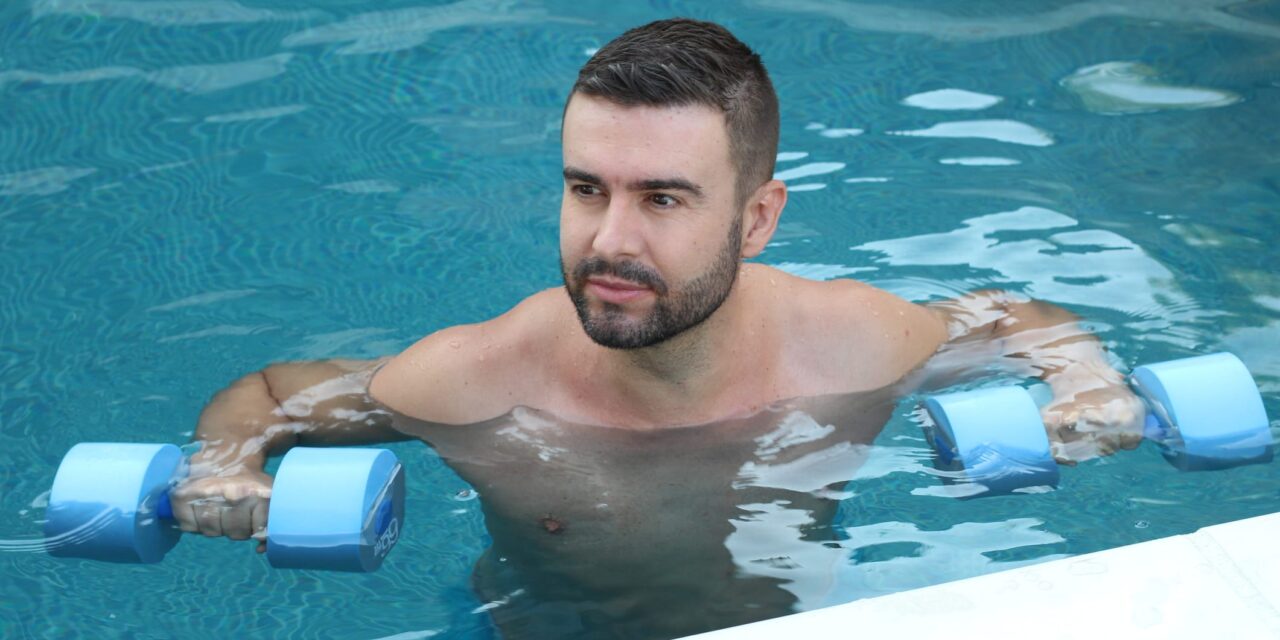From pumps to power systems, aquatic therapy comes with unique maintenance and safety demands.
By Steve C. Keith, CBET, CET
In rehab medicine, few interventions combine science and serenity quite like aquatic therapy. What began centuries ago as ritual healing in thermal springs has matured into a clinically rigorous practice backed by modern physics, therapy protocols, and a whole lot of biomedical oversight.
Today, aquatic therapy is used across hospitals, VA systems, and wellness facilities to treat everything from spinal injuries to cardiac recovery—often with better outcomes than traditional land-based rehab alone.
But while patients float their way to improved mobility, an entire infrastructure beneath the surface makes those sessions possible. For biomedical professionals, aquatic therapy zones are a high-stakes balance between therapeutic benefit and technical responsibility. And as the modalities become more sophisticated, so too must the systems that support them.
From Ancient Baths to Modern Rehab: A Brief History of Aquatic Healing
Long before “aquatic therapy” entered clinical vocabulary, water was already doing the work. Ancient Egyptians bathed in mineral springs to treat ailments as early as 2400 BC. Hippocrates prescribed immersion for pain and injury, and Roman bathhouses became centers for public health and recovery. These weren’t just places to bathe—they were engineered environments for healing.
In 1911, Dr Charles Leroy Lowman pioneered underwater gymnastics for children with cerebral palsy, using water’s buoyancy to reduce strain and encourage movement. By 1924, President Franklin D Roosevelt was using aquatic therapy to manage polio symptoms in Warm Springs, Ga, bringing national attention to hydrotherapy as a legitimate medical intervention.
| Year | Milestone | Impact |
|---|---|---|
| 2400 B.C. | Egyptian mineral baths | Earliest recorded therapeutic use of water |
| 400 B.C. | Hippocrates prescribes immersion | Foundation of hydrotherapy principles |
| 100 A.D. | Roman bathhouses | Public health and recovery infrastructure |
| 1911 | Dr. Lowman’s underwater gymnastics | Birth of modern aquatic therapy |
| 1924 | FDR’s polio treatment in Warm Springs | National spotlight on hydrotherapy |
| 1980s–Present | APTA recognition and clinical integration | Standardized protocols and clinical adoption |
Today, aquatic therapy is a recognized specialty under the American Physical Therapya Association (APTA), with standardized protocols and equipment used across diverse clinical settings—from outpatient rehab pools to VA hydrotherapy suites.
The Pull of the Pool: Why Water Works
Water offers a fascinating combination of properties that make it uniquely therapeutic. Buoyancy reduces joint and spinal pressure, making even painful movements feel manageable. Hydrostatic pressure—think of it as an invisible hug—helps reduce swelling and stabilize blood pressure. Water’s natural resistance strengthens muscles without weights, and warmth soothes pain while improving circulation.
Together, these qualities create an ideal setting for early mobilization, strength building, and neurological retraining. Patients recovering from strokes, orthopedic surgeries, or chronic pain often find that aquatic therapy allows them to move in ways that would be impossible on land.
What Powers Aquatic Therapy Behind the Scenes
Each aquatic modality has its own distinct approach and gear, and for biomedical professionals, understanding the nuances is essential:
- Hydrotherapy uses whirlpool tubs and underwater treadmills for arthritis, surgical recovery, and gait training. These systems require precise temperature control, filtration, and pH balance—just like any other clinical water system, but with added complexity due to patient immersion.
- Halliwick therapy, popular for neurological rehab, involves variable-depth pools with handrails and balance platforms to encourage trunk control and rotational movement.
- Clinical Ai Chi blends slow, meditative movement with ambient light and sound systems to promote relaxation and parasympathetic activation. These sensory elements must be waterproof, EMI-safe, and electrically isolated.
- Bad Ragaz therapy uses floating rings and therapist-guided resistance techniques, similar to proprioceptive neuromuscular facilitation (PNF) but adapted for water. Motion cameras may track movement patterns for therapeutic alignment.
- Motor-cognitive aquatic therapy combines floating obstacles with memory games and gait trainers to help stroke and dementia patients improve balance and cognition.
- Cardiovascular aquatic training includes submerged bikes, aqua jogger belts, and waterproof telemetry monitors to ensure heart rate zones remain safe and effective.
Across all modalities, devices like Watsu mats, pool lifts, aquatic resistance equipment, and hydro-massage systems come into play. Every single piece demands calibration, safety testing, and compliance documentation.
Preventive Maintenance: Keeping Aquatic Systems Safe, Stable, and Serviceable
While therapy pools may appear low-maintenance compared to imaging suites or surgical theaters, their mechanical and electrical systems operate under constant stress—heat, humidity, chemical exposure, and patient interaction. Preventive maintenance isn’t just a best practice; it’s a clinical safeguard.
- Pumps and Circulation Systems: Pumps drive hydro-massage jets, filtration loops, and underwater treadmills. They require regular inspection and performance validation.
- Recommended Actions:
- Inspect for cavitation, air entrainment, and impeller wear
- Check seal integrity and motor bearings for corrosion or vibration
- Validate flow rates using calibrated flow meters
- Confirm intake alignment and debris screens to prevent dry running
- Monitor motor temperature and amperage draw for overload or imbalance
- Recommended Actions:
- Plumbing and Filtration: Plumbing systems must maintain consistent flow, pressure, and water quality.
- Recommended Actions:
- Inspect PVC and CPVC joints for stress fractures or degradation
- Test pressure relief valves and backflow preventers
- Flush and sanitize filter housings per CDC MAHC guidelines
- Verify chemical dosing systems for calibration and leaks
- Monitor pH, ORP, and chlorine sensors for drift; recalibrate quarterly
- Recommended Actions:
- Heaters and Thermal Control: Heaters are essential for patient comfort and therapeutic efficacy—but they’re also high-risk components.
- Recommended Actions:
- Evaluate heater connections for corrosion and torque loss
- Measure current draw under load; compare to nameplate ratings
- Inspect grounding paths for continuity and bonding
- Test overcurrent (OC) relays for trip thresholds and reset function
- Validate GFCI operation monthly using external testers
- Confirm temperature sensor accuracy within ±0.5°C
- Recommended Actions:
- Electrical Isolation and Safety Systems: Any submerged or splash-zone device must be isolated, bonded, and tested regularly.
- Recommended Actions:
- Perform leakage current testing per NFPA 99
- Inspect bonding conductors and equipotential grids
- Validate EMI shielding on sensory systems and telemetry gear
- Confirm emergency shutoff switches are accessible and functional
- Document inspection intervals and test results in compliance logs
- Recommended Actions:
Maintenance Scheduling Tips
| Component | Frequency | Notes |
|---|---|---|
| Pumps & Motors | Bi-Annual | Include amperage draw and vibration analysis |
| Heaters | Bi-Annual | Prioritize GFCI and OC relay testing |
| Plumbing & Filters | Per Adopted Infection Control Standard – Monthly | Sanitize per CDC MAHC and ANSI/AAMI ST108 |
| Electrical Systems | Bi-Annual | Include leakage current and grounding checks |
| Sensors & Controls | Bi-Annual | Recalibrate and validate against reference data |
Wet Procedure or Not? The Regulatory Gray Zone
Ask 10 facilities whether their therapy pool qualifies as a wet procedure location under NFPA 99, and you might get 10 different answers. Some treat it as a low-risk zone; others apply full wet-location protocols with GFCI protection, isolated power systems, and redundant bonding.
For biomedical technicians, navigating this ambiguity requires both technical insight and collaborative judgment.
Technician’s Checklist:
- Conduct a risk assessment with clinical and engineering staff
- Document all bonding and grounding paths
- Verify component compatibility during repairs
- Align maintenance schedules with ANSI/AAMI ST108 guidelines
Reference Standards You’ll Want Handy:
| Guideline | What It Covers |
| NFPA 70 (NEC) | Defines wet procedure locations and electrical safety |
| NFPA 99 | Classifies risk levels and sets biomedical testing rules |
| ANSI/AAMI ST108 | Water quality and microbial control standards |
| ISO 10993 | Biocompatibility of patient-contact materials |
| CDC MAHC (2024) | Therapeutic pool operation protocols |
| Rigel NFPA 99 Guide | Practical testing methods for biomed applications |
| IOAPT Guidelines | Global aquatic physiotherapy standards |
| ATACP Practice Guide | UK-based aquatic therapy safety assessments |
| APTA Aquatic PT Manual | Evidence-based rehab guidelines |
| AEA Fitness Standards | Environmental and equipment best practices |
Final Thoughts: What’s Below the Surface Counts
Aquatic therapy may look serene from above, but underneath, it’s a dense layer of devices, diagnostics, and standards. For biomedical personnel, it’s a chance to merge compliance, creativity, and clinical impact in a space where healing and hazard co-exist.
When the patient steps into the water, every calibrated sensor, every safety inspection, and every line of code matters. So, before anyone dives in, make sure the equipment is ready to go deep.
ID 208842350 | Aquatic Rehab © Alberto Jorrin Rodriguez | Dreamstime.com
About the Author: Steve Keith, CBET, CET, has worked in the biomedical equipment field since the early 1980s, with experience spanning hospitals, manufacturers, distributors, and consulting. He has served as a technical trainer, field support specialist, and engineering consultant across a range of medical technologies. He holds certifications as a certified biomedical equipment technician and as an ISCET Certified Electronics Technician with a biomedical journeyman specialization. He is currently the director of technical support at Medical Maintenance.





